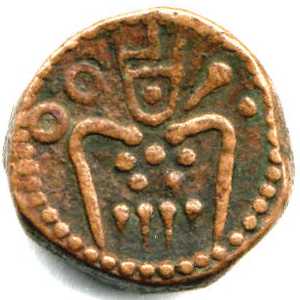
TTa M
Na
On 1658 July 23, the Dutch took Negapatnam from the Portuguese. In 1662 it was granted the half Mint Custom by a concession of the Nayak of Tanjore. From 1673 to 1680 it was under the Government of Ceylon. In 1690 the head office for the Coast of Coromandel, moved in from Pulicat until in 1784 the Dutch were forced to hand it over to the British.
Codrington Mentions two varieties of Copper coins fron Negapatnam. The older coins figure of goddess Kali which were minted for circulation in Ceylon described below, and coins with N above the VOC monogram issued for circulation within the limited area of the Company.
(1) 50, 25 and 5 Cash.
Based on weight given in Scholten
they should be 40, 20 and 2.5 cash.
Obverse : A degenerated human Facing figure of goddess Kali of
Tanjore. Above to left OO two
annulets. To right over the "left shoulder" an object commonly called
the "club" and a thick dot. Sides end in dot which with the two
additional rows; (3 dots and 2 dots below) form a tight 7-dot motif on
the breast. Below 4 dots with tails pointing down. All within dot circle.

| N A Ka Pa TTa M Na |
Scholten states that a large number of die-varieties with narrow, tall or broad "body", high and round "sholders" exist. Codrinton points out that the obverse is somewhat similer to the Viraraya Fanam.
| KM# | Scholten# | Value | Rarity | Codrington | On_Weight | Link | |

| |||||||
| 29 | 1243 | Double Stiver | RRR | 50 Cash | 40 Cash | coin | |
| 28 | 1244 | Stiver | RR | 25 Cash | 20 Cash | coin | |
| 26 | 1245 | Doit | R | 5 Cash | 2.5 Cash | coin | |
| 25 | 1246 | half Doit | RRR | Unlisted | 1 Cash | coin | |
The half Doit listed in Scholten as exteamly rare.
Although they bore the name Negapatnam on the reverse they were intended principally for Lanka. A letter dated 1693 Dec 8th from Batavia to Colombo and a letter of 1695 July 14th from the Seventeen to the Indies saying: It is ordered to strike at Negapatnam up to 100,000 guilders of double and single stivers and also to cause doits to be struck at the full value of the copper in the markets roundabout.
The terms stivers and Doit used for these coins in Scholten comes from
this quote.
The computation of expected weight based on market price given
in Scholten and quoted by Krause seems to be much rougher
than the specified ±3% range in weight..
At the time the price of a (Troy) pound (or 494 grams) of copper
was 35 to 37 stivers and according to Van Dam II.2, p 390, the Sinhala
coppersmiths now had to pay no more than half the price.
Scholten computes 3.432 per doit, and 27.432 for Stiver which would then be 8 doits.(Isn't 8 doits = 2 Stiver). According to Valentyn (1726) 80 cassen or casjes = 1 fanam = 5 stiver i.e. 1 Stiver = 16 Cash - all very confusing. Probably reflect changes in exchange rate between different monetary systems over time.
Goddess Kali [Hindi=the Black One] known also as Durga [the Inaccessible] and as Chandi [the Fierce], Kali is associated with disease, death, and destruction. As Parvati she is the consort of Shiva. Although often represented as a terrifying figure, garlanded with skulls and bearing a bloody sword in one of her many arms, she is worshiped lovingly by many as the Divine Mother. Her cult, popular among many lower castes in India,
Text edited from
* Ceylon Coins and Currency By H. W. Codrington. Colombo 1924
NEGAPATNAM Chapter X Dutch Page 138
The Coins of the Dutch Overseas Territories- 1601-1948 by C. Scholten, 1953,
Amsterdam: Jacques Schulman. Chapter X NEGAPATNAM page 141.
I thank Barbara Mears of UK for the Identification of the Tamil legend.